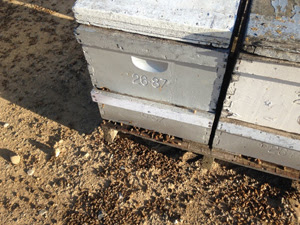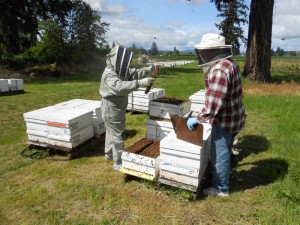An unprecedented and devastating bee kill occurred this past month at the end of the almond bloom. Affected beekeepers, the Pollinator Stewardship Council (info@pollinatorstewardship.org) and the American Beekeeping Federation (www.abfnet.org), plus representatives of EPA, met Monday, March 24 in Los Banos, California to discuss the pollinator losses. 75 beekeepers attended in person or via conference call.
A poll taken of the 75 beekeepers reveled 80,000 colonies damaged, 75% of them severely. Attendees indicated 40% of colonies lost adult bees and had dying brood, 20% of the hives were dead completely. A quick tally estimated that of the 1.7 million total colonies used to pollinate CA almonds this season, fifteen to twenty-five percent (255,000 to 425,000 colonies) might have suffered damage (i.e. dead colonies or loss of brood/ adult foragers). The conservative value of beekeeper losses was calculated at $63,750,000 to $106,250,000; however beekeepers are still assessing their damages. This figure did not include the loss of viable colonies to satisfy subsequent pollination contracts, nor the use of colonies to produce and sell packages/nucs, rear queens for sale (or to put in the packages), or use of frames of brood to establish new hives. With severely damaged hives beyond a brood generation, some beekeepers have been forced to cancel orders and others wondered if they might be able to provide adequate sized colonies for pollination of PNW tree fruits.
The losses were primarily experienced by beekeepers who wintered in California, as well as those who brought their bees into almonds. Losses were heavier in the lower central valley but also in the Modesto area. At least five OR beekeepers had pesticide damage to over 4000 colonies. John Jacobs (current SOBA president) reports he did not have losses and in fact thought his colonies were in really good shape. John said there were adequate healthy colonies for the Medford-area pear orchards, moved in the 3rd of April.
Bee colony losses were attributed to a tank mix that included an insect growth regulator (IGR) and a fungicide applied “per the label.” Research has shown fungicides in synergy with other pesticides are detrimental to pollinators. (http://westernfarmpress.com/fungicides-can-reduce-hinder-pollination-potential-honey-bees). Research last season by Reed Johnson of Ohio State (Johnson, R. & E. Percel (2013). The effects of the fungicide pristine on queen rearing. 2013 ABRC Abstracts Amer Bee Jour April) pinpointed how addition of an IGR, in his study Pristine (= dimilin, diflubenzuron), to the tank mix of the fungicide application was capable of harming queens. Other research has shown treatment of bees with a pyrethroid miticide can lead to bee losses when growers subsequently apply a common fungicide. California almond growers used a different IGR, Intrepid (=methoxyfenozide). Ironically the target insect pests, peach tree borer and leaf rollers, are very minor almond pests that can be targeted later in the season if a problem.
Many beekeepers expressed grave concern that although the lethal tank mix was applied in one area, honey bees from other orchards under another grower’s pollination contract, received damage due to drift and overlapping foraging range. The effects of fungicides and IGRs were delayed just enough so beekeepers did not realize the extent of the damage to colonies until the bees had returned to their home apiaries. The most severely affected bee colonies lost a brood generation and the effect often lingered into the next cycle from stored pollen. Beekeepers at the Los Banos meeting stated they have been experiencing damage to their bees in almonds for six years
Experience has shown night applications of pesticides in almonds causes less damage to pollinators or did not apply any pesticide products during the bloom. Paramount Farms, the largest almond grower in the world, testified at the meeting they use no crop protection products during almond pollination season, and have found their yields improved when they made the decision to better time their pesticide use. This year growers were applying the fungicide to protect early nut development from a blossom rot. Addition of the IGR, as an “insurance”, a ‘just-in-case situation’, is not a new practice.
Beekeepers at the meeting asked EPA for two things:
- add a statement on the label instructing applicators when and how to apply pesticides to not damage pollinators
- curtail tank mixing.
EPA representatives stated they were not aware of the issues the bee industry had concerning the new label language. EPA made no promise to do anything, stating that changing label wording is a long and drawn out process that cannot be done quickly.
Beekeepers on the other hand did make promises: promises to add a pesticide surcharge to pollination contracts next year and if no enforceable change to labels is made before next years’ pollination they will stay home and make honey in a safe environment rather than risk another season of severe hive damage.
It is obvious that what happens to honey bees in almonds does not stay in almonds; it affects how many bees are available to pollinate other crops, the cost of pollinating those crops, and the cost of the food you buy to feed your family.
Dr. Caron taught at the University of Delaware for 40+ years with teaching, extension and research with honey bees (and entomology and wildlife conservation) and now holds an Affiliate position (volunteer) with Horticulture Dept (the bee unit specifically) at Oregon State University. He is active in Eastern and Western Apiculture societies and national bee groups. He is the Vice President of the Oregon State Beekeepers’ Association and served as President in 2010. He serves on the board of the Western Apiculture Society. He is an honored speaker at SOBA programs whenever he is available.
Dr. Caron’s book HONEY BEE BIOLOGY AND BEEKEEPING is available on Amazon.


